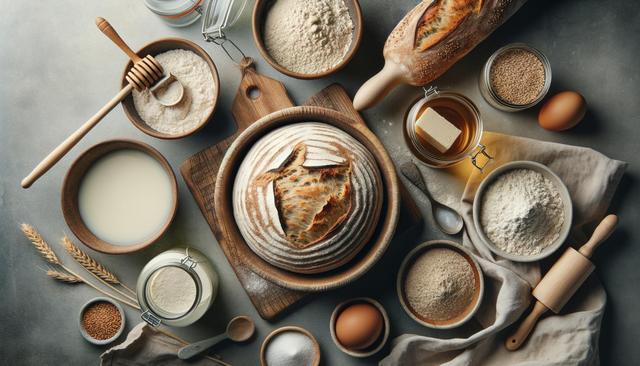
How to Make Sourdough Bread at Home: A Beginner’s Guide
Understanding Your Sourdough Starter
Before you can bake sourdough bread, you’ll need a sourdough starter. This is a live culture of flour and water that captures wild yeast from the environment. Unlike commercial yeast, sourdough starter ferments slowly, giving the bread its signature tangy flavor and chewy texture. To create a starter from scratch, you’ll mix equal parts of flour and water daily for about 5 to 7 days. During this time, the mixture will begin to bubble and rise, indicating active fermentation. The key to a healthy starter is consistency and patience. Use a clean glass jar, keep it loosely covered, and store it at room temperature.
Signs of a mature starter include:
- Doubling in size within 4–6 hours after feeding
- A pleasant, slightly tangy aroma
- Many bubbles on the surface and throughout
Once your starter is active and reliable, you can begin baking. Always reserve a portion of the starter to continue feeding and maintaining it for future baking sessions.
Gathering the Right Tools and Ingredients
Successful sourdough baking doesn’t require fancy equipment, but a few essential tools will make the process smoother and more consistent. Here’s a basic list to get you started:
- Digital kitchen scale – for accurate measurements
- Mixing bowls – glass or stainless steel are ideal
- Dough scraper – helpful for mixing and shaping
- Proofing basket (banneton) – for shaping and supporting the dough
- Cast iron pot or Dutch oven – for baking and creating steam
In terms of ingredients, sourdough bread uses only a few simple components:
- Unbleached flour – all-purpose or bread flour works well
- Filtered water – free from chlorine, which can inhibit fermentation
- Salt – enhances flavor and controls fermentation
- Sourdough starter – your homemade culture
Choosing high-quality flour and water can significantly impact the flavor and texture of your bread. As you gain experience, you may experiment with whole grain flours like rye or spelt to add depth to your loaves.
The Sourdough Bread Process: An Overview
Making sourdough bread from start to finish typically takes around 24 hours, depending on temperature and fermentation times. Here’s a simplified breakdown of the process:
- Feed the starter: Refresh your starter 4–6 hours before mixing the dough.
- Mix the dough: Combine flour, water, and starter. Let it rest (autolyze) for 30–60 minutes.
- Add salt: Mix in salt and begin bulk fermentation.
- Stretch and fold: Every 30 minutes for the first few hours to build gluten.
- Bulk fermentation: Let the dough rise until it has nearly doubled in size.
- Shape the dough: Gently shape and place it in a proofing basket.
- Cold retard: Refrigerate overnight to enhance flavor and structure.
- Bake: Score the top and bake in a hot Dutch oven.
Each step plays a vital role in developing the bread’s flavor, structure, and crust. Don’t rush the process—sourdough rewards patience and care.
Tips for Shaping and Scoring
Shaping your dough properly helps it rise evenly and develop a beautiful structure. After bulk fermentation, gently preshape the dough and let it rest for 20–30 minutes. Then reshape it tightly, trying not to deflate the dough. Place it seam-side up in a floured proofing basket. The cold retard phase in the fridge helps firm the dough, making it easier to score before baking.
Scoring is more than decoration—it allows the bread to expand in the oven without tearing. Use a sharp blade or a bread lame and make confident slashes. Score just before baking, and be sure your oven and Dutch oven are preheated thoroughly to around 475°F (245°C).
Common shaping mistakes include:
- Under-proofing – leading to dense, gummy crumb
- Over-proofing – causing the dough to collapse in the oven
- Not shaping tightly enough – resulting in flat loaves
Practice makes perfect, and every loaf will teach you something new about dough handling and fermentation.
Storing and Enjoying Your Sourdough Bread
Once your loaf is baked, let it cool completely on a wire rack before slicing. Cutting too early can result in a gummy crumb. Sourdough bread stays fresh longer than commercial loaves due to its natural acidity, which helps prevent mold.
For storage:
- Keep at room temperature in a paper bag or wrapped in a clean towel
- Avoid plastic bags, which trap moisture and soften the crust
- Slice and freeze extra bread for long-term storage
You can enjoy sourdough in many ways—toast with butter, sandwiches, or dipped in soups. If your loaf starts to dry out, revive it by lightly toasting or turning it into croutons or breadcrumbs. Don’t discard stale sourdough; it can be repurposed into delicious dishes like bread pudding, French toast, or even panzanella salad.
With time, your baking will improve, and you’ll be able to adjust hydration, fermentation time, and flour blends to suit your taste. Keeping a bread journal can help track your progress and note what works best for your environment and schedule.
Conclusion: Start Your Sourdough Journey Today
Making sourdough bread at home is a rewarding process that combines creativity, science, and tradition. While it may seem intimidating at first, following a consistent routine and learning from each bake will build your confidence. Whether you’re baking for your family or experimenting with new techniques, sourdough offers endless possibilities. Start with the basics, embrace the imperfections, and enjoy the journey toward flavorful, homemade bread.


